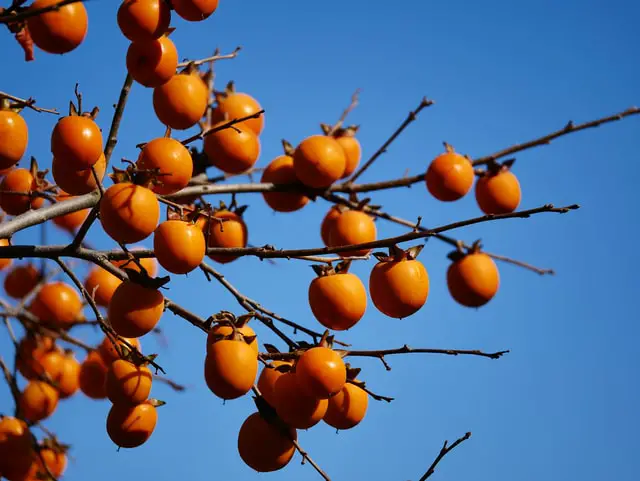Persimmon also goes by the common names Sharon fruit and Chinese date plum. The fruit flesh is juicy, and yellow or orange. Persimmon trees are classed as hardy and can tolerate temperatures as low as -10°C. This means they are ideal for growing in the UK climate.

Persimmons belong to the Ebenaceae family and are deciduous tree. Despite being exotic trees developed on the Sharon plains, they can cope well with low temperatures. These are large trees, growing up to heights of 12 metres at their tallest which can be achieved over 20-50 years.
The pretty foliage gives them bragging rights in UK gardens. You’ll be in awe of the glossy green leaves which then turn to a coppery plum colour in the Autumn. Bell-shaped yellow flowers appear during the summer followed by tomato-shaped edible fruit in September. When the leaves drop and the fruit remains it’s a sight to behold.
Persimmons can be used for many tasty recipes including in cakes, soups, chutneys, fruit slices, salads, crumbles, and cheesecakes.
Jump To...
How To Grow Persimmon Trees in the UK
Persimmon trees are classed as hardy plants, even the youngest trees can handle temperatures as low as -10°C. As well as being attractive to look at, persimmon trees produce juicy edible fruit that stays on the tree once ripened.
To ensure yours is getting the best care it can, read up on our care guide for getting the most out of your Persimmon tree.
- You are best planting your persimmon tree after the last frost has gone and when spring has turned warmer. This gives your fruit tree a chance to acclimatise without being too cold in its first 6 months in your garden.
- You can plant straight into your garden or, alternatively, grow in a container. Pot-grown Persimmon will need repotting every one or two years and replaced with a larger type. They need plenty of sun, some shelter, and should ideally be located in a south or west-facing direction.
- Fruit is ready when it turns a deep orange in colour and can be picked in September. It can, however, remain on the tree until you are ready to pick it and it looks very autumnal at this point.
- Pruning isn’t a difficult task when it comes to persimmon trees and doesn’t require much work at all. Pruning can occur in late winter or early spring and any diseased branches should be removed. It’s also important to remove any crossing shoots to make sure plenty of daylight is getting through. Once you’ve pruned you can place mulch around the base to keep it healthy.
- It’s important to get the watering technique correct as over-watering is the main reason so many trees and plants die. If the roots become too wet you will end up with root rot. More watering will be required during hot spells and much less will be needed when it’s cooler.
- When it comes to planting your Persimmon tree, they like soil that isn’t too moist and is well-drained. They will tolerate several conditions but so like loamy soil.
- Oriental persimmons are self-fertile so will produce a decent fruit yield on their own. Some other varieties, such as American types, may need two trees. Often, gardeners choose mint as a good accompaniment to their Persimmon.
About Persimmon Trees a.k.a Sharon Fruit
The name Sharon Fruit was derived from the Sharon plains in Israel, where the fruit was developed. It became popular in countries such as Japan and Korea, later introduced to California in the mid 1800s.
Did You Know?
- Persimmon actually belongs to the berry family.
- They provide twice as much fibre as your regular apple does.
- Japanese persimmons are native to China.
- Today, you’ll find Persimmon growing in Israel, Spain, South Africa, California, and the Gulf states.
Persimmon Tree FAQ’s
We sum up all we haven’t yet covered, here are our handy little Persimmon FAQS.
Persimmon trees grow to between 8 and 12 metres in height, with a spread of 4 to 8 metres.
It can take persimmon trees up to 7 years to bear fruit but then supplies will be plentiful.
Some varieties will need two trees to produce fruit but others, such as Oriental persimmons, are self-fertile.
Persimmon trees lose their leaves once the fruit is ripe or almost ripe in the autumn. This gives the trees a gorgeous autumnal look with the bare branches and succulent orange fruits.


hi, I’ve had my persimmon for 5 years and this year it flowered and I’ve got fruit! Yay.. My fruit are dropping before they turn totally orange is this normal? Also, it seems the variety that I’ve got is the type that has to be very ripe before you can eat it. The skin is thick and flesh soft but currently still ‘dry’. Which variety has the persimmon you can eat when still hard like an apple? Thanks for any advice
I’ve had mine 15 years first blossom
and fruit this year. Don’t give up!
Will they cope with heavy clay soil that is amended? With the previous posts, what varieties did you get?
Hi
i have which very green and grown to 5 meters, it is over 7year old, but no fruits as yet.
Any advice ?
in staffordshire .
I’ve had a tree in for 8 y which has never flowered
My one is 9 y.o. and is finally going to blossom for the first time. Hurray!
Same here..trees 9 years and ibhave 3 fruits for the 1st time! Hurray!
Is it possible to buy persimmon trees on a dwarfing rootstock?